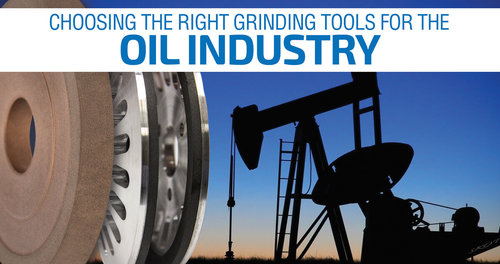The Best Grinding Tools for the Oil Industry
The grinding wheels used in petroleum engineering must be specifically developed to provide the performance needed for these applications. Common grinding applications in the oil industry include the manufacture of drill bits, gage blocks and wear parts. Superabrasives made from polycrystalline diamond (PCD) and carbide are common in this industry, especially for drill bits. Additional types of abrasives used on an oil rig include bonded abrasives and coated abrasives.
Benefits
The benefits of abrasives that have been custom developed for oil and gas applications include greater effectiveness, efficiency and tool life. Grinding tools need the latest bonds to deliver the precision needed for grinding the PCD and carbide bits used in modern drilling. These bits often use centerless wheels that offer a high cutting depth with high grind ratios, which cut costs during grinding operations. PCD abrasives are also used on tools that perform highly-efficient chamfer grinding.
Diamond Abrasives
Diamond abrasives usually refer to abrasives made with PCDs. They are most common in the manufacture of down-hole drill components such as drill bits made to gage. These bits are used in a variety of applications such as centerless, chamfer, form and surface grinding.
Bonded Abrasives
Bonded abrasives include resinoid abrasives and vitrified abrasives. Wheels that use these abrasives in the oil and gas industry can perform both precision and rough grinding applications. Components that are ground with wheels that use bonded abrasives typically have a hard face with a durable coating. These components include the following:
Couplings
Down hole stabilizers
Frac pump plungers
Pistons
Polish rods
Pony rods
Reamer shoes
Shafts
Valves
Bonded abrasives often use proprietary bond and grain formulas to provide performance gains over traditional abrasives such as silicon carbide and aluminum oxide. These benefits include longer grind cycles and a net reduction in cost per part.
Coated Abrasives
Coated abrasives may be used in a variety of forms such as belts, discs, rolls, sheets and wheels. These products are typically composed of cloth, fiber, film and paper for applications that include rough grinding, finishing, lapping and polishing. Products that use coated abrasives can be found in virtually every segment of the oil and gas industry, including petrochemical plants, oil reserves, pipelines and rigs.
Structured abrasives are commonly used to create a consistent finish, while flexible abrasives provide excellent results in high-velocity oxygen fuel spraying applications. Coated abrasives with an agglomerate grain are often used to improve performance with non-woven products such as convolute wheels, belts and discs. Users who wish to lower their total costs for coated abrasive products should consider ceramic belts, flap discs and specialty discs.


